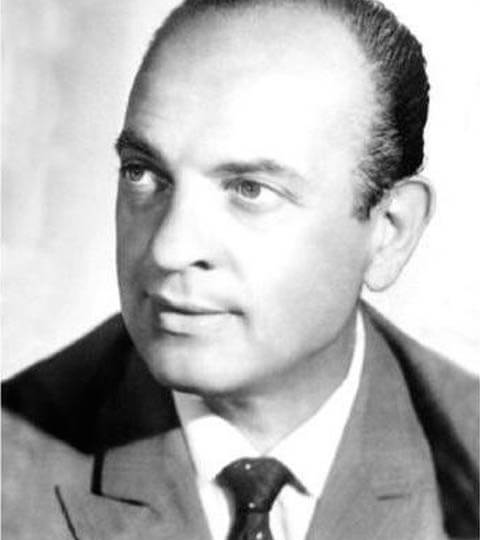(from Wikipedia and El Recodo)
Bandoneonist, leader and composer (28 October 1907 – 24 May 1972)
He formed his first orchestra in 1929, which he later dissolved to join the orchestra of the pianist and poet Cátulo Castillo with which he toured Spain in which the brothers Ricardo and Alfredo Malerba and the singer Roberto Maida also participated .
Back in Buenos Aires he formed a new orchestra with the bandoneonist Domingo Cuestas, the violinists Domingo Varela Conte, Hugo Gutiérrez and Enrique Valtri, the double bassist Enzo Ricci and the pianist Luis Brighenti, which he later left to join Fresedo’s orchestra with the one who traveled to the United States .
In 1932 he recorded for the first time, recording with the voice of Román Prince for the Splendid label the tango Milonga Porteña – music by Caló and Luis Brighenti with lyrics by Mario César Gomila – and the waltz Amarguras by Miguel Nijensohn and Jaime de los Hoyos. Both that year and the following, Caló joined Raúl Kaplún with violin and Luis Brighenti on piano, the Puloil Trio, named after the brand of a cleaning powder manufactured by the sponsor of a radio singing contest that was broadcast on Radio Splendid. in which the trio accompanied the participants.
In 1934 he formed a new orchestra, with a style clearly influenced by Fresedo and a sound reminiscent of Di Sarli . In the ensemble was the pianist Miguel Nijensohn, who left a mark that would last forever in his style: his instrument was in charge of stringing together the musical phrases, with a cadence and rhythm ideal for the dancers. It is worth highlighting the contribution of the singer Carlos Dante , with whom he recorded 18 songs of relevant beauty.
As of 1937 his orchestra had Argentino Galván as arranger and in 1939 it included Raúl Berón as singer . Alberto Morel and his brother Roberto Caló were also singers at that stage. In 1942, the directors of the station where Caló played suggested that he cut ties with Berón because they were not satisfied, but at that moment the album they had recorded for Odeón on April 29, 1942 appeared with the tango Al compás del corazón by Domingo Federico and Homero Expósito and the waltz The dreamer waltz was so successful that the directors themselves revised their opinion.
At the beginning of 1943 Alberto Podesta left Miguel Caló’s orchestra to join Pedro Laurenz‘s ; The lyricist Oscar Rubistein, better known as Oscar Rubens, told Caló about the work of Raúl Iriarte and the director, after hearing him sing, hired him for his orchestra, which at that time was made up of the violinists Enrique Mario Francini , Aquiles Aguilar, Antonio Bogas and Mario Lalli, the bandoneon players, Domingo Federico , Armando Pontier , José Cambareri and Felipe Richiardi, the pianist Osmar Maderna and the double bassist Armando Caló. On May 17, 1943, they recorded their first album together, which had on one side the tango It’s in vain to cry by Oscar Rubens and Alberto Suárez Villanueva and on the other side Jorge Ortiz singing the tango De Barro , by Sebastián Piana and Homero Manzi . On August 10, 1943 he recorded two tangos by Carlos Bahr that were well liked by the public, Mañana I will go early and Every day I miss you more . It was his most brilliant period for Iriarte, which continued until December 1945, during which the Caló orchestra recorded 43 songs, of which only 7 were instrumental;
Especially remembered from the period, in addition to those mentioned, are the versions sung by Iriarte of Marión , Nada , Tabaco y Trenzas and the last one, which was the tango by Homero Expósito and Enrique Francini, Óyeme . 3 Iriarte was the singer who made the most recordings in the Caló orchestra. In 1943 he left the Domingo Federico orchestra and the following year Raúl Berón left Demare and returned to the Caló orchestra, integrating with Iriarte a couple of singers that allowed him to compete in the most popular orchestras of the moment, the by Juan D’Arienzo , Carlos Di Sarli and Aníbal Troilo . At the end of 1945, Enrique Mario Francini and Armando Pontier left the orchestra to co-direct their own ensemble, while Maderna and Iriarte agreed to become independent, forming a duo, but shortly after the singer returned to Caló while Maderna debuted with his own orchestra at the Marzotto café .
Sample Tango Music by Miguel Caló
The songs below are representative of tango music as a whole. There are three types of Tango music that you’ll hear at a Milonga (a tango dance party):
1.) Tango, which is 4/4 time, meaning there are 4 beats per measure.
2.) Milonga, which is a style of music, a dance party itself, and a style of dance done to the style of music. Milonga music is typically 2/4 time, meaning there are 2 beats per measure and has a very distinctive type of rhythm which is known as the ‘Habanera’ Rhythm.
3.) And lastly there is Vals music which has a very distinctive ‘lilt’ to the music indicative of 3/4 time signature or 3 beats per measure.
Que Te Importa Que Llore – Tango Example
Pedacito De Cielo – Vals Example
Milonga Que Pena Canas – Milonga Example
Habanera Example Used In Milonga Music.

